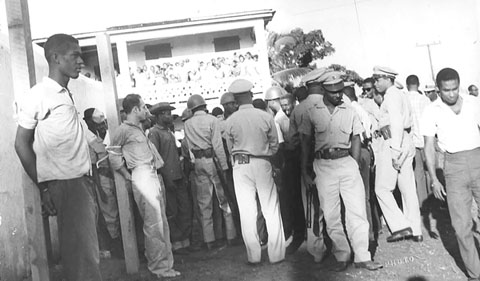Marcel Numa and Louis Drouin (at left), moments before their execution; Port-au-Prince, November 1964
. . . on November 12, 1964, two pine poles are erected outside the national cemetery. A captive audience is gathered.
Radio, print, and television journalists are summoned. Numa and Drouin are dressed in what on old black-and-white film seem to be the clothes in which they’d been captured — khakis for Drouin and a modest white shirt and denim-looking pants for Numa. They are both marched from the edge of the crowd towards the poles. Their hands are tied behind their backs by two of Duvalier’s private henchmen, Tonton Macoutes in dark glasses and civilian dress. The Tonton Macoutes then tie the ropes around the men’s biceps to bind them to the poles and keep them upright.
This week, the CRB is very pleased to publish an essay by the Haitian-American writer Edwidge Danticat, excerpted from her new book. She begins by telling the story of the execution of two young Haitian activists, Marcel Numa and Louis Drouin, at the order of the dictator François “Papa Doc” Duvalier. This event, Danticat explains, is one of her personal “creation myths.” The story of these brave young men is her starting-point for a bracing consideration of the importance of literature, of the act of writing and the act of reading, in dangerous times:
When it was a crime to pick up a bloodied body on the street, Haitian writers introduced Haitian readers to Sophocles’s Oedipus Rex and Antigone, which had been rewritten in Creole and placed in Haitian settings by the playwright Franck Fouché and the poet Felix Morisseau Leroy. This is where these writers placed their bets, striking a dangerous balance between silence and art.
How do writers and readers find each other under such dangerous circumstances? Reading, like writing, under these conditions is disobedience to a directive in which the reader, our Eve, already knows the possible consequences of eating that apple but takes a bold bite anyway.
How does that reader find the courage to take this bite, open that book? After an arrest, an execution? Of course he or she may find it in the power of the hushed chorus of other readers, but she can also find it in the writer’s courage in having stepped forward, in having written, or rewritten, in the first place.
Also published in the CRB this week: the latest in our special series of film reviews, supported by the trinidad+tobago film festival. Ian Craig looks at Los Viajes del Viento (The Wind Journeys), a “road movie” set along Colombia’s Caribbean coast, directed by Ciro Guerra.
Finally, this week we launch our new music column, which focuses on new releases from underexposed Caribbean genres as well as classic recordings and performances of the past. It begins with B.C. Pires’s review of The Longest Kiss Goodnight, the latest album from the Trinidadian rock band jointpop (your Antilles blogger is a fan), and John Robert Lee’s essay on the late St Lucian folk singer Sesenne Descartes and her classic 1991 album, now scheduled for re-release.






{ 1 comment… read it below or add one }
Of historical interest — You can see a clip of Toussaint’s last moments in prison from the award-winning new short film “The Last Days of Toussaint L’Ouverture” at http://www.imdb.com/name/nm2468184/ This film is the basis for a new feature (not with Danny Glover) that is in development.